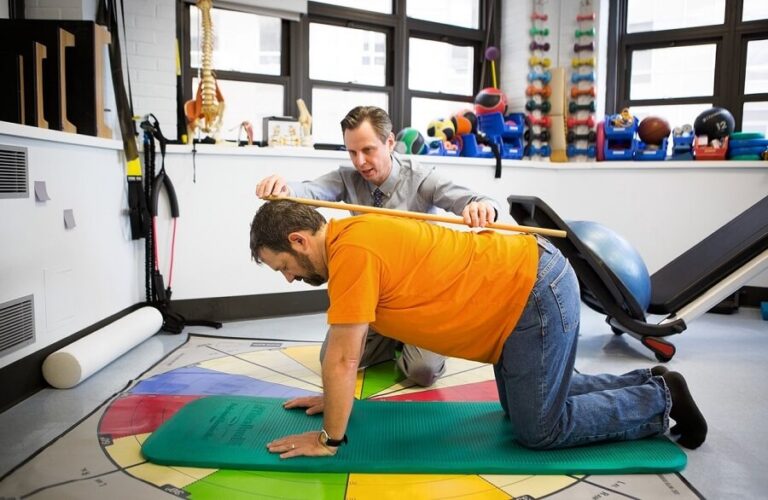The abdominal vacuum, also known as hypotensive abdominals, is one of the exercises that has aroused the most curiosity in the networks. Interest has been generated by a challenge known as the stomach vacuum challenge.
Fitness professionals indeed use it to work the internal abs, as it is an exercise used in yoga to improve breathing techniques.
If this is the first time you’ve heard the term hypopressive abs, read on to find out what the abdominal vacuum technique is like and the benefits of this exercise.
Recommended: What happens if you do an abdominal vacuum every day?
Abdominal Vacuum: What is it?
The abdominal vacuum exercise or hypopressive abdominal exercise is a helpful exercise to tone and strengthen the internal muscles of the abdomen.
Doing the abdominal vacuum works the transverse muscles of the abdomen and the diaphragm muscles.
In bodybuilding, they are known as hypopressive abs and are used to achieve a narrow waist and a more slim figure. In yoga, the abdominal vacuum is known under the name “uddiyana bandha” and is considered an essential breathing exercise.
The correct technique of the abdominal vacuum exercise involves drawing the air out of the abdomen as much as possible for at least 30-40 seconds. To learn to do the abdominal vacuum, you should practice the exercise at least 2-3 times a week.
How to do the abdominal vacuum exercise? – Correct technique
It is recommended to do the abdominal vacuum exercise in the morning on an empty stomach or 1-2 hours after the last meal. A full belly will put extra pressure on internal organs and make exercise techniques difficult.
Beginners are recommended to begin with the abdominal vacuum exercise by lying down. The sitting or standing position is also suitable, considering that you should lean the posture slightly forward and with your hands on your knees.
The main secret of the vacuum technique is learning to feel the tension of the transverse abdominal muscles below the ribs. Once you’ve got this feeling, the exercise method becomes much easier for beginners. The process of the abdominal vacuum exercise is:
- Sitting on the floor, take a deep breath and exhale the air from your lungs.
- Continuously breathe in through your diaphragm deeply.
- Tensioning the abdomen tries to bring the mood up.
- Connect the internal muscles of the stomach and try to connect the navel with the spine.
- Hold your breath with muscle tension for 10-20 seconds
- Relax your muscles little by little and release the air gently.
Benefits of the abdominal vacuum exercise
The transverse muscles tighten the body and provide support for proper posture. When most of the day sitting in front of the computer, they lose their tone, their waist increases in volume, and their figure deteriorates.
One of the benefits of doing a daily abdominal vacuum is reducing your waist circumference and strengthening your inner abs. (1) Ultimately, hypopressive abs allow you to work your abdomen much more efficiently.
In addition, one of its additional benefits is learning the different breathing techniques that exist. So it is one of the chosen exercises in yoga. Also, doing abdominal exercises can correct poor posture.
Although they can strengthen the abdomen, great results should not be expected in reducing body fat percentage. During the core vacuum, large amounts of calories are not expended. The benefits of empty abdominal exercise are:
- Develop the transverse or internal abdominal muscles
- Strengthen the muscles of the diaphragm
- Improve the neuromuscular connection with the abdomen
- Learn breathing techniques
Tips on technique for beginners
To achieve more precise hypopressive abdominals, a beginner can perform the exercise without a shirt and in front of the mirror; This will facilitate the control of the abdomen to a great extent.
Remember that large fat stores in the abdominal region can make the abdominal vacuum exercise more difficult for a beginner.
In this case, starting with the abdominal planks is recommended to warm up. Pan on the elbows for 10 seconds and then start with the hypopressive abs.
Hypopressive abs. How many series, how many repetitions a day?
A beginner must perform 3 to 10 repetitions of the exercise daily. In the beginning, you can start with 10 seconds of vacuum and 20 seconds to restore breathing.
Once the technique has been learned, it can be gradually increased until reaching 40-60 seconds of vacuum.
It is recommended to do an abdominal vacuum at least 3-4 times a week to obtain its benefits.
Abdominal vacuum vs. abdominal planks vs. crunches
The abdominal vacuum exercise is designed to exercise the transverse and internal abdominal muscles located on the sides of the waist and perpendicular to the spine.
Most dynamic abdominal exercises (crunches, leg raises, etc.) develop the rectus abdominis muscle. Variations of these exercises allow you to create oblique muscles.
The abdominal planks allow you to strengthen and tone the muscles of the entire body and are ideal as a physical warm-up exercise.
Does vacuum exercise help reduce belly fat?
Since the emptiness of the abdomen is static and does not expend a significant amount of calories, it is not the best exercise to reduce abdominal fat. Even though it allows for strengthening the waist muscles, it is not an excellent method to eliminate body fat.
To burn fat, you nemusthange your diet and combine it with different tyrdio or high-intensity workouts. Good results in burning fat with hypopressive abs should not be expected.
One of the main advantages of the abdominal vacuum is the significant development of the mental connection between the abdominal muscles and the brain. You will learn to control the internal abdominal muscles and reduce the waist with the correct technique. Ultimately it can help you achieve the six-pack.
Contraindications of abdominal vacuum
The abdominal vacuum exercise is considered safe for most cases. However, it has several contraindications. It is prohibited during pregnancy or the menstruation period. It is not recommended in cases of infectious diseases in the stomach, such as colitis or gastritis.
In addition, hypopressive abs can significantly increase blood pressure, so it is contraindicated for people with high hypertension. It is not an impact exercise, so it is allowed for teenagers and people with joint problems.
ABSTRACT
The abdominal vacuum is an effective diaphragmatic breathing-based exercise for strengthening the internal muscles of the abdominals.
The key to learning to do hypopressive crunches is to feel the tension in your transverse muscles when you breathe.
Beginners are recommended to perform the abdominal vacuum exercise lying down or sitting with a slight incline.
Once the technique is learned, the vacuum time can be gradually increased.







